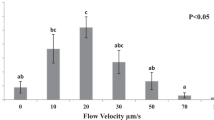Abstract
Background: Sperm cells are assessed in an in vitro setting under conditions that are quite different from their natural environment: low viscosity media, high oxygen content, often in a two-dimensional setting. The natural environment often includes highly viscous fluids in branched microchannels, which changes the sperm motion significantly. Physical factors such as surface and fluid properties might have a significant impact on successful sperm migration and therefore in sperm selection procedures.
You have full access to this open access chapter, Download conference paper PDF
Similar content being viewed by others
Background: Sperm cells are assessed in an in vitro setting under conditions that are quite different from their natural environment: low viscosity media, high oxygen content, often in a two-dimensional setting. The natural environment often includes highly viscous fluids in branched microchannels, which changes the sperm motion significantly. Physical factors such as surface and fluid properties might have a significant impact on successful sperm migration and therefore in sperm selection procedures.
Main Questions: How do sperm move in body fluids? How can we emulate in vivo conditions in the laboratory?
Experimental Design: Bovine sperm cell motion is investigated in highly viscous media and isolated bovine oviduct fluid. Metabolic measurements are conducted with a Seahorse device for measuring oxygen consumption and extracellular acidification rates.
Main Results: Sperm cells swim with straighter paths and lower average lateral head displacement in high viscosity media and oviduct fluid. The metabolic rates of bovine sperm cells that have migrated in a swim-up procedure to the upper fraction are higher, while the ATP content of such sperm is lower. Swim-up sperm of the upper fraction tend to have longer flagella than sperm in the lower fraction.
Conclusions: It is worth investigating sperm behaviour in emulated body fluids to gain a better understanding of in vivo sperm migration.
Author information
Authors and Affiliations
Corresponding author
Editor information
Editors and Affiliations
Rights and permissions
Copyright information
© 2021 Springer Nature Switzerland AG
About this paper
Cite this paper
Magdanz, V., Eckel, B., Reinhardt, K. (2021). Sperm Motion and Metabolism in Physiological Conditions. In: Björndahl, L., Flanagan, J., Holmberg, R., Kvist, U. (eds) XIIIth International Symposium on Spermatology. Springer, Cham. https://doi.org/10.1007/978-3-030-66292-9_35
Download citation
DOI: https://doi.org/10.1007/978-3-030-66292-9_35
Published:
Publisher Name: Springer, Cham
Print ISBN: 978-3-030-66291-2
Online ISBN: 978-3-030-66292-9
eBook Packages: Biomedical and Life SciencesBiomedical and Life Sciences (R0)




